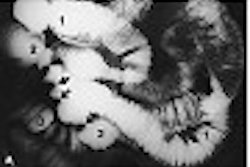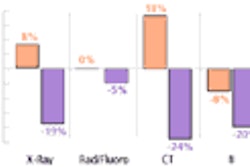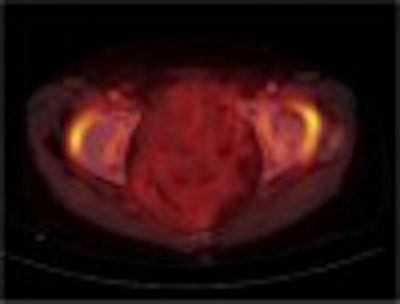
CHICAGO - The use of positive oral contrast agents can be a tricky business when utilizing the CT portion of a PET/CT scanner for attenuation data in a gastrointestinal study, according to researchers from Essen, Germany. These agents, such as iodine, may induce artifacts into the PET emission data if PET attenuation correction is based on the CT scan.
"On a quantitative basis there may be an overestimation of concentrated PET activity; on a qualitative basis, there may appear to be an apparent uptake of tracer," said Dr. Gerald Antoch of the department of radiology at the University Hospital of Essen.
Antoch and his research group investigated three negative oral contrast agents for dual-modality PET/CT imaging: barium, plain water, and a mannitol/locust bean gum compound. The team imaged 60 patients with different oncological diseases in the axial field of view using a dual-modality PET/CT (Biograph, Siemens Medical Solutions).
A 1-liter solution of 1.5% barium was given to 20 of the patients, another 20 were given 2 liters of plain water, and the remaining 20 were given a 2-liter solution containing 2.5% mannitol and 0.2% locust bean gum.
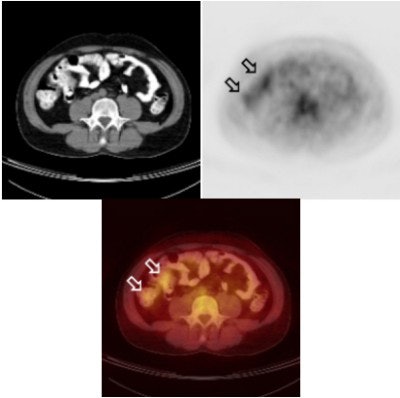 |
| CT (left), PET (right), and PET/CT (bottom) with barium as an oral contrast agent demonstrate apparent increased glucose metabolism in good co-registration with the contrast-enhanced bowel loop. Image and caption courtesy of Dr. Gerald Antoch, department of radiology at University Hospital of Essen. |
"Locust bean gum is derived from the Southern European Carob tree, and was combined with the mannitol by our pharmacy department for purposes of this study. We added an orange flavor to make it more palatable," noted Anotch.
To assess the intestinal distension, two radiologists measured five diameters each of the stomach, the jejunum, and the ileum. The PET images were evaluated qualitatively for areas of increased bowel FDG uptake as well as quantitatively by determination of standard uptake values (SUV) of five typical small bowel loops, according to the researchers.
"Phantom measurements were performed to quantitatively assess the effect of the different contrast agents onto the CT-based PET attenuation correction," said Antoch.
The group found that intestinal distension with its locust bean gum/mannitol solution proved superior over both the plain water and barium. In addition, patients who swallowed the locust bean gum/mannitol solution had less of an urge to urinate during the study, an important consideration when conducting a PET/CT exam that may take a half-hour or longer, observed Antoch.
Antoch reported that the mean diameters for the stomach were 6.4 (+/-1.8) cm with the locust bean gum/mannitol preparation with water showing 6.1 (+/-1.5) cm, and barium 5.0 (+/-1.1) cm. The jejunum was distended to 2.1 (+/-0.3) cm, with water 1.6 (+/-0.3) cm, and with barium 1.9 (+/-0.3) cm. The diameters of the ileum averaged 2.0 (+/-0.3) cm, water 1.4 (+/-0.3) cm, and barium 1.9 (+/0.20) cm, he said.
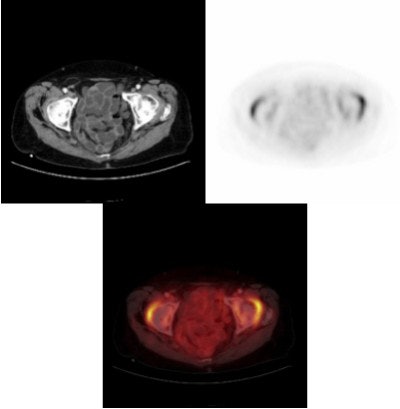 |
| When applying a negative oral contrast agent such as a locust bean gum/mannitol solution, there is homogeneous tracer distribution on both PET (right) and PET/CT (bottom). (Note the glucose uptake in the area of both hips, most probably due to inflammatory reaction.) Image and caption courtesy of Dr. Gerald Antoch, department of radiology at University Hospital of Essen. |
A quantitative analysis of the bowel’s glucose uptake by the researchers resulted in SUVs of 1.8 for the locust bean gum/mannitol solution, 1.7 for water, and 2.5 for barium.
"Increased glucose uptake was demonstrated more often in the presence of barium than with water or the locust bean gum/mannitol when evaluated qualitatively," noted Antoch.
The assessment of the phantom studies revealed an overestimation of the tracer activity concentration within the phantom by 33% in the presence of barium, although the activity concentration was not overestimated in the presence of water and locust bean gum/mannitol, he said.
”Although the locust bean gum/mannitol solution is not commercially available, it is not very difficult to prepare, and our results demonstrate that it shows promise as a negative oral contrast agent in PET/CT imaging as it provides good stomach and bowel distension while avoiding potential contrast-induced PET artifacts,” said Antoch.
By Jonathan S.
Batchelor
AuntMinnie.com staff writer
November 30, 2003
Related Reading
PET/CT is the team to beat for NSCLC staging, November 17, 2003
Financial analysis brings new perspectives on PET/CT acquisition, November 14, 2003
Copyright © 2003 AuntMinnie.com






